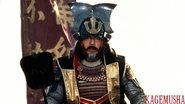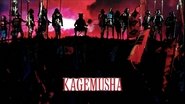ChicRawIdol
A brilliant film that helped define a genre
Catangro
After playing with our expectations, this turns out to be a very different sort of film.
Kinley
This movie feels like it was made purely to piss off people who want good shows
Scarlet
The film never slows down or bores, plunging from one harrowing sequence to the next.
diggus doggus
I think you, viewer, and reader of this review, should avoid Kagemusha.Here is why.I'm a long standing fan of Kurosawa, and i consider Rashomon and Shichinin no Samurai two of the greatest films ever made; Kagemusha, is a very, very different beast.First off, it's a three hour marathon. I grew up in the 70s and 80s and it was not uncommon for directors to write cinema-quality films that lasted for five or six hours, which would then be serialized on TV. But to stomach the whole of these 187 minutes, it takes the most hardcore film snob.The main story is of, Toshiro Mifune (which has carried the brunt of Kurosawa's work), here as a lowly thief who is at the right place at the right time. He looks just like a local lord who has just died, so they put him in place as Kagemusha, or "stunt double". There is an opposing clan (the Oda/Tokugawa alliance) which wants to attack them, but they are scared of the lord's tenacity.Now, this film has tons of fantastic acting, superb touching moments from Mifune, as he changes - like his character does - from thief into feudal lord, more and more adapting to the role within the role.But it's also three bloody hours.See, the issue here is that the classic "hero" solution cannot work; this is a historical piece and Mifune's character must fail, despite how much we root for him. This not only leads to disappointment, but also sets the film's needs for lengthy and complex developments of the background, rather than focusing on the character arcs, such as 7 Samurai does.And this is why i have a hard time recommending Kagemusha to the viewer. It's a documentary interspersed with some character drama, but if you are not prepared to watch over two hours of medieval troops marching, i suggest you give this a miss. It's a shame because with some solid editing you could get a 1-hour film of great class; but then again maybe a re-write would be better.8/10 - it might be a masterpiece, but it's not a FILM masterpiece.
riolama
This is the best movie I have ever seen. In any language from any culture. I thought so when I first saw it thirty years ago and I still think so now, despite not being able to see it in its original mind- blowing wide-screen form. It is not just one of the most visually beautiful films ever done. The positive reviews are all accurate, but many focus too much on Kurosawa in general rather than on the particular theme of this film, which is closely tied to Japanese history and ideals, and which unites all the specific beauties of text and technique. This is not simply a film about historical belatedness (a lament that the ancient idea of heroes is now exposed by the modern world to be a hollow fantasy, as Ebert and other suggest), or the Shakespearian tragedy of inevitable discrepancy between individual and historical role, as in Henry V), although the film includes something of these elements. It is more--a beautiful elegy to a positive feudal ideal of leadership that goes beyond individual power to sacrifice for country--embodied in the figure of Takeda Shingin. Great tactician, unsurpassed "rider" of horses and women, inspiring and fearsome military leader, he is also a student of the Sutras and a man who "stepped right into people's hearts," as one of his aides says. The opening scene shows he listens to criticism and has a sense of irony about himself; when the thief who is to play his "double" accuses him of being a murderer, he agrees but says he will do anything to unite the country in order to prevent endless war and bloodshed. The same actor plays the lord and his double with incredible depth and subtlety. Shingin is killed (by a gun) early in the movie; as he is dying he tells his generals not to let anyone know he's dead for three years--to let the thief replace him, so as to give the clan time to prepare for confrontation with the western- armed enemy--and, given that his clan is not armed with western firearms, not to move out of its own territory. The double or "shadow warrior" who takes his place begins to identify with the role and finds out that literal crucifixion (for theft) would have been nothing compared to the loneliness at the top where the weight of the world is on the leader's shoulders. Every moment of his existence requires that he sacrifice everything personal to a role that no one can ever fill perfectly, and that is now bereft of the one man who came closest to doing so. The kagemusha doesn't have Shingin's "riding ability" or his wounds or the depth of self-understanding to fill the lord's role and, when he cockily believes he can do so for a moment, he is discovered and thrown out. Neither he, nor any modern man trying to live an identity larger than himself--including the artist who, like the kagemusha, is creating a shadow of the ideal--can replace this feudal ideal which was superseded (literally, massacred at the end) starting over 400 years ago by Christianized and technologized decadence, represented by Nobunaga and Ieyasu. The kagemusha learns slowly, as we do, what the ABSENCE of the irreplaceable Shingin means to his people and symbolically to Japan. Many scenes build up as if to a great battle or political confrontation, and the generals keep the show going, but it is all hollow--the leader is gone. Shingin's ambitious and over-eager son then leads the Takeda clan out of the mountains--to a destruction by western technology reminiscent of Hiroshima and Nagasaki (especially since the historical battle was at a place named Nagashino). The point of the film is to show a lost ideal of the past which can never be regained and without which everything afterward is a shadow, like the kagemusha ("shadow warrior"). The double (like the artist) seems possessed with Shingen's ghost in the last scenes as he watches in horror while the son, in a self-centered Oedipal frenzy, destroys the flower of his people by moving beyond the legitimate limits of his territory and his scope, and the double can only throw a futile spear at the modern weaponry which destroys him. But a shadow identity from a meaningful past is better than none at all (Kurosawa shores these fragments against modern ruins at least as well as T.S. Eliot in "The Waste Land").
sboom2009
Another samurai epic by the master of the genre Akira Kurosawa; which, I find to be a mostly fulfilling attempt.The film follows the life of a peasant thief named Kagemusha who happens to look like the warlord of the Takeda clan Shingen. He is found by Shingen's brother Nobukado where he is trained to be Shingen's third body double in case of emergency. Of course this fate is realized when a assassin's sniper rifle finds Lord Shingen during a battle. Shengin remains alive for a while to let his men know that he wanted to be alive three more years for it was his goal to capture Kyoto and if he should die he would want it kept a secret so his clan would not go into disarray. Unfortunately Shingen passes from his wound and it is decided by the his cabinet that Kagemusha must pretend to be Shingen for three years (this secret is even kept from Shingen's family).It is important for his double to keep his persona for if his enemies were to suspect lord Shigen dead then they wouldn't have fear of attacking, but knowing that he may still be living made them second guess their attacks and kept the clan safe. It also helped to protect the clan from itself for the warlords replacement was a mere boy and a son who is blanketed by his father's shadow who is trying desperately to find himself(which is a major theme of the film).Their are many themes in this film of which to talk about but the most important one is finding ones self. Shingen's son Katsuyori is very lost even before his father's death. His son is the next in line to become leader of the clan ,which; brings him much embarrassment for he has felt his father was not fairing of him making him want to distance himself from Shingen's lore. These feelings later in the film become cataclysmic as certain discoveries are made. Kagemusha himself is lost between loyalty to his master and still knowing himself ,which; he is not able to be under the circumstances. There is a point in the film when he takes the persona too far it has dire consequences, but it puts things back in perspective for him where he finds what he truly loves.The first two hours of the film are phenomenal, but the battle sequences once began got a little confusing at times especially a scene at night where you're not sure who the friends or enemies are. I didn't fully understand the sequence until it had ended and I felt it was the weakest part of the film lasting I believe between 15-20 minutes. I wasn't a big fan of the ending also it felt a little rushed to me for Kurosawa ,which; I find to be out of character for him, but I will say the films final shot was magnificent.To Conclude I would say that despite the weak final act the rest of the film was very entertaining with an interesting premise and strong characters. If you are a Kurosawa fan you will love it as I did, however; it is definitely not in the category of Seven Samurai, or Roshomon. Visually astounding(the nightmare sequence was my favorite) at times and maybe a little confusing at others in the end it is to good of a film to pass up on even if it has its flaws.
njmollo
Katsu's KagemushaKagemusha (1980) is unique motion picture. The cinematography and epic scope are at times simply stunning but something still haunts this motion picture, the "what could have been?" In Kagemusha, the lead roles of Lord Shingen Takeda and the thief, were written for the actor Shintarô Katsu but due to an on-set falling out with Akira Kurosawa, Katsu was promptly fired and Tatsuya Nakadai was quickly re-cast. Some have said that Akira Kurosawa wanted to make Kagemusha a comedy. This assumption is strengthened because Shintarô Katsu was famous in Japan as the endearing and comic character Zatoichi, the blind wandering Yakuza. Yet Kagemusha while having some comic moments was never intended to be a film trapped by a single genre. Seven Samurai/ Shichinin no samurai (1954) has many comic scenes but no one would call it a comedy. Kurosawa's life experiences had made him understand that tragedy and comedy were frequent bedfellows. Often in times of stress, disaster or war, humour is a necessary release. Even Kurosawa's darkest films have elements of comedy.The main complaint about Kagemusha is that Tatsuya Nakadai gives a theatrical and cold performance. In Tatsuya Nakadai's long acting career, he excelled in villainous roles. As an actor he retained a certain detachment that suited cold-blooded parts. He could not translate an easily identifiable or sympathetic humanity for an audience, nor could he effortlessly employ humour as Toshirô Mifune or Shintarô Katsu so often did. While Tatsuya Nakadai gives a heartfelt and dramatic performance as the thief, the audience remains an observer rather than an investor in the character.Shintarô Katsu was a talented actor. He had the ability to give each part a striking individuality. His Zatoichi character became one of the most popular in Japan and spawned 26 movies and over 100 television episodes. Yet in other film roles Shintarô Katsu showed his abundant skill by transforming himself so completely that the blind Yakuza, Zatoichi became unrecognisable. Shintarô Katsu's natural charisma can be seen in his superb performance in Hitokiri/ Tenchu! (1969) as a block-headed samurai assassin, Izo Okada. Incidentally, this film co-stars Tatsuya Nakadai as another cold and calculating character, a clan leader that orders Izo Okada from assassination to assassination with heartless efficiency. Shintarô Katsu's character is a murderer and kills on command yet his performance allows the audience to sympathise with his dilemma. When Izo Okada breaks down in a stunning scene of heart breaking grief, the audience is firmly on his side. Playing a ruthless and dim-witted killer could so easily alienate the audience and it is a testament to Shintarô Katsu's talent that the bloodthirsty character becomes so sympathetic.Shintarô Katsu's other famous, or should I say infamous, creation is the character of Hanzo: The Razor, a perverted and sadomasochistic policeman, in a trilogy of exploitation films. The first and the best is called Goyôkiba/ Hanzo the Razor: Sword of Justice (1972), directed by the underrated and hugely talented Kenji Misumi. Yet again, Katsu plays a thoroughly despicable character that the audience can root for. It is clear that the casting of Shintarô Katsu was an inspired decision and it seems the actor was enthusiastic and excited to be given the chance to play the role. Like Toshirô Mifune, Shintarô Katsu had been making films for his own production company. He had the reputation as an individualist with at times, an unbridled ego. Unfortunately Shintarô Katsu was unable to subjugate himself to Akira Kurosawa. He needed to put aside his own presumptions of being a famous Japanese movie star and submit completely to Kurosawa's direction. This he was unable to do and it resulted in a row that led to Akira Kurosawa firing Shintarô Katsu on the spot.It is a lasting shame that someone as talented as Shintarô Katsu could not reign-in his own ego for the duration of the Kagemusha production because this would have been the first time that Shintarô Katsu, the actor, would have been presented to an international audience by one of the worlds most esteemed directors. He may have been remembered as one of Japan's great leading men rather than the popular yet domestic star in a series of Zatoichi movies.What would have Shintarô Katsu brought to the roles of Lord Shingen Takeda and the thief, Kagemusha? Lord Shingen Takeda would have been much the same as is seen in the final version of Kagemusha. A Lord that is stayed and dignified. The dynamism would have come with Katsu's interpretation of the thief. Here we would have seen the effortless comedy coming from the actor and also the accessible humanity. The audience would have had a despicable yet charming character to empathise with and enjoy.Presumably, there would also be moments of inspired improvisation with Shintarô Katsu experimenting with comedic options or tragic interpretations. This may have caused on-set difficulties but Kurosawa would have accepted differences of interpretation if the actor's motivations were authentically based on the character's motivations and not simply expressions of an actor's ego. Still the filmmaking involved in Kagemusha is so assured and striking that it can arguably be regarded as one of the most beautiful pictures ever made yet what remains is the stunning artistry of the images and not the performances or emotion.Shintarô Katsu would have given the film a much needed heart. As it stands Kagemusha is an Akira Kurosawa movie rather than a Shintaro Katsu tour de force.












